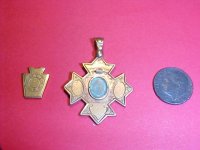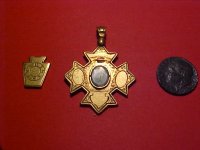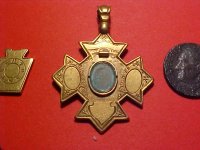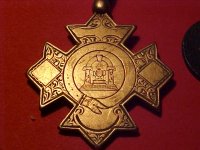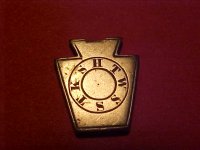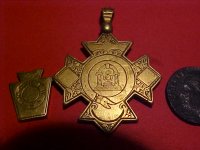This was found in a field of an old Homestead 1700s ? Any idea of age Thanks for the help . Have other pics if needed .Mark
Navigation
Install the app
How to install the app on iOS
Follow along with the video below to see how to install our site as a web app on your home screen.
Note: This feature may not be available in some browsers.
More options
You are using an out of date browser. It may not display this or other websites correctly.
You should upgrade or use an alternative browser.
You should upgrade or use an alternative browser.
Need Help Iding This Cross
- Thread starter T Hunter
- Start date
since i found the cross i went back to the field and found a gold ring. took it to club meeting and discovered that it had initals in it the initals are j.m.h or j.w.h we think it may have belonged to john haslets wife her name was jamima we are still checking but i am starting to think this is haslets home site. the museum has narrowed it down to that spot so it looks very good. i had a jweler look at the ring and he said he had never seen a stone like this one. so he looked it up and found out that it,s a moss agate . very neat it looks like a clear stone oval and it apears to have moss under it but it,s in the stone. i will try to grt a picture later today.
Upvote
0
naturegirl
Bronze Member
- Mar 21, 2009
- 2,356
- 403
Banner!?! My first banner vote. Why wouldn't it be? It's exciting.
naturegirl
naturegirl
Upvote
0
ivan salis
Gold Member
- Feb 5, 2007
- 16,794
- 3,810
- 🏆 Honorable Mentions:
- 1
- Detector(s) used
- delta 4000 / ace 250 - used BH and many others too
with hair being in it I'd say mid to early 1800 era --once photographs came on the scene in about mid 1800's -- placing hair in lockets rapidly became "old hat" with better off folks --and photographs of the loved one was used instead hair in their lockets -- to be able to "see" ones loved one was quite a treat when they were far away. (and much more "up to date" fashion wize)
Upvote
0
Bigcypresshunter
Gold Member
- Dec 15, 2004
- 27,000
- 3,339
- Detector(s) used
- 70's Whites TM Amphibian, HH Pulse, Ace 250
- Primary Interest:
- Beach & Shallow Water Hunting
I found a locket of hair in a small pouch full of Civil War buttons.
Upvote
0
ivan salis
Gold Member
- Feb 5, 2007
- 16,794
- 3,810
- 🏆 Honorable Mentions:
- 1
- Detector(s) used
- delta 4000 / ace 250 - used BH and many others too
yes for folks that could not afford photos (they were costly) or for those who like to have a "piece" of their loved one with them --- a locket of hair was a very popular item to keep as a keep sake ---with buttons and hair together it might have been the buttons of his uniform and bit of hair of a dead soldier that his wife, lover --or a mother might have kept.as a keepsake.
Upvote
0
BuckleBoy
Gold Member
ivan salis said:yes for folks that could not afford photos (they were costly) or for those who like to have a "piece" of their loved one with them --- a locket of hair was a very popular item to keep as a keep sake ---with buttons and hair together it might have been the buttons of his uniform and bit of hair of a dead soldier that his wife, lover --or a mother might have kept.as a keepsake.
So the piece could date as late as 1900.

Upvote
0
ivan salis
Gold Member
- Feb 5, 2007
- 16,794
- 3,810
- 🏆 Honorable Mentions:
- 1
- Detector(s) used
- delta 4000 / ace 250 - used BH and many others too
nope I would say if they can afford at have a solid gold masonic cross like this money was not really a issue with them --- and they would have had a photograph most likey if one had been avialible rather than hair or along with hair (behind the photo)---so in my veiw its most likely -- a pre photograph era "hair locket" ---say 1840 to 1790's era -=-- by the way -- upon his death --george washingtons widow sent bits of his hair out to various masonic persons and lodges upon his death --could this "hair" be a keep sake of his dear freind --fellow masonic brother ---george washington? ---if it is indeed the property of who they think it belonged to its very possible .--- and could account for it being in such a "fancy" item .
for the wealthy "photographs" in lockets took over once the age of "pictures" came into being (about mid 1800's)---the practice of keeping a "locket"of hair was done mainly by the poor folks after "photos" came on the scene -- those who could not afford photos --or by those who wanted a "phyiscal part" of their loved ones.
for the wealthy "photographs" in lockets took over once the age of "pictures" came into being (about mid 1800's)---the practice of keeping a "locket"of hair was done mainly by the poor folks after "photos" came on the scene -- those who could not afford photos --or by those who wanted a "phyiscal part" of their loved ones.
Upvote
0
BuckleBoy
Gold Member
ivan salis said:nope I would say if they can afford at have a solid gold masonic cross like this money was not really a issue with them --- and they would have had a photograph most likey if one had been avialible rather than hair or along with hair (behind the photo)---so in my veiw its most likely -- a pre photograph era "hair locket" ---say 1840 to 1790's era -=-- by the way -- upon his death --george washingtons widow sent bits of his hair out to various masonic persons and lodges upon his death --could this "hair" be a keep sake of his dear freind --fellow masonic brother ---george washington? ---if it is indeed the property of who they think it belonged to its very possible .--- and could account for it being in such a "fancy" item .
for the wealthy "photographs" in lockets took over once the age of "pictures" came into being (about mid 1800's)---the practice of keeping a "locket"of hair was done mainly by the poor folks after "photos" came on the scene -- those who could not afford photos --or by those who wanted a "phyiscal part" of their loved ones.
But why not Both? I didn't know that hair lockets and photographs were mutually exclusive.
 Who came up with that notion? And where are the supporting citations of works or research to show this?
Who came up with that notion? And where are the supporting citations of works or research to show this? I suspect that this is another case of making an item into the find that you want, instead of the find that it is.
The style of the engraved letters on this piece screams mid-to-late 1800s. Perhaps this piece was Presented to an upper level Mason--Not purchased. What does that do the "theory" that they had enough money to be able to afford a photograph? I think this is a case again of wild speculation about the origins of this piece, with little or no basis in Fact.
But unless another example with a clear date or attribution is found and posted here, there will be no way to know how old this one is--and you can take that to the bank.
Best Wishes,
Buckles
Upvote
0
the big reason i think this cross is from the 1700,s is because the ground i found it at has been in the owners family since 1860,s and they have never been able to plow deeper than 8". so , ifound the cross at about 12 1/2 inches deep. if they dropped the fob in 1860 it has settled in the ground an additonal 4 1/2" thats my thaughts
Upvote
0
ivan salis
Gold Member
- Feb 5, 2007
- 16,794
- 3,810
- 🏆 Honorable Mentions:
- 1
- Detector(s) used
- delta 4000 / ace 250 - used BH and many others too
buckle boy -- wait before slinging mud ---- some folks did have hair and a photo --photo in front --hair behind it -- and I said some folks that wanted a "phyiscal bit" of their loved ones still used a locket of hair even later on --hell some folks today even do--- but knowing that the rage of photography took over in the mid 1800's -- is hardly rocket science --- the practice of photographing "dead" loved ones --was very common -- and photographs of the dead were hung in the homes to "remember them by." --- my 200 year old family bible has exactly those type of photos in it --of "dead" folks -- also having a phootograph made was a "big" deal --one had to be dressed just right -- as it was costly to have photos made wealthier folks tended to do so more often than poor folks --(common sense at work there) --- so having your photo taken was "high fashion"-- the stuff "rich folks" do -- and even back just as today t folks tried to keep up with the jones. --- plain old hair lockets became "old fashioned" --photographs in lockets were the "in" thing -- no I do not have volumes of professor dingleberry's papers to back it -- just a knowledge of past practices and habits of my hillbilly kin folks from west by god virginny -- who still got pre and civil war era old "creepy" photos of the dead laying in their coffins on their walls. --as a kid I asked why do you have those creepy old photos up on the wall --- a very very old granny type explained it to me. and showed me the very very old family bible which now stays in my home. --in it my family lineage and kin folk on my mothers side can be traced over 200 years -- from about 1860 thru the 1880 era there were several "death photos " of the type I speak of. ---photographs of living loved ones were also done of course.
the basis of my knowledge is oral history * --- I was about 10 when I was told about this by my then about 70 year old "granny" type relative of the hills --- that was 38 years ago --- so 38 and 70 makes time go back 108 years -- she said she as a child also learn of this from her old "granny" --- so if she was say 10 when she learned it thats 98 years ago tthat she learned it from her granny -- the civil war was from 145 to 149 years ago --minus 98 years --thats an additional 47 to 51 years ago -- thus her 70 year old "old granny" would have been a young lady of 15 to 19 years of age during the war years and would know "first hand" as she lived it.
and would know "first hand" as she lived it.
the basis of my knowledge is oral history * --- I was about 10 when I was told about this by my then about 70 year old "granny" type relative of the hills --- that was 38 years ago --- so 38 and 70 makes time go back 108 years -- she said she as a child also learn of this from her old "granny" --- so if she was say 10 when she learned it thats 98 years ago tthat she learned it from her granny -- the civil war was from 145 to 149 years ago --minus 98 years --thats an additional 47 to 51 years ago -- thus her 70 year old "old granny" would have been a young lady of 15 to 19 years of age during the war years
 and would know "first hand" as she lived it.
and would know "first hand" as she lived it.
Upvote
0
IronSpike
Silver Member
I agree with both ivan salis and BuckleBoy.
Hairlock makes it more likely to be an early piece. It doesn't give a definitive date, but could date rather far back. Piece not linked based this observation. Would think the hair lock could be dated, but not sure what a test like that would cost.
The piece is a banner find as is
Hairlock makes it more likely to be an early piece. It doesn't give a definitive date, but could date rather far back. Piece not linked based this observation. Would think the hair lock could be dated, but not sure what a test like that would cost.
The piece is a banner find as is

Upvote
0
72cheyenne
Bronze Member
- Dec 6, 2004
- 1,463
- 25
- Detector(s) used
- Minelab E-trac, White's M6, White's 6000di/pro
- Primary Interest:
- All Treasure Hunting
Yes I agree with ivan and Buckles too. Ivan has made some good points, but BB has to. Without hard evidence of it is really unfair to try and say a piece is from any particular era. Not taking away from the significance of this find, it is still a good find, and so is the ring that you found at the same site. Messick, you metioned depth as a possible determining factor. In totally undisturbed soil, it may hold true to date things by the layers they come from. Archies do it all the time, but in your case of a plowed field, even though you say they only plowed 8" max and the cross was found at 12", doesn't mean that the cross couldn't have been "mashed" into the ground the additional depth. If you were finding exclusively late 1700s to early 1800s item, then I would say it would most likely be from that era, but that still wouldn't prove it 100%. But since we are throwing guesses out, I will say 1850s-1860s. Still super nice and i would still be proud to find it if it was made in the 1950s. 

Upvote
0
ivan salis
Gold Member
- Feb 5, 2007
- 16,794
- 3,810
- 🏆 Honorable Mentions:
- 1
- Detector(s) used
- delta 4000 / ace 250 - used BH and many others too
depth on a plowed feild --is not a solid date indacator I must agree --in undisturbed ground --strata sets up in "layers" and many things can be dated by depth -- but a plowed feild throws this to the wind (which is why archie type folks hate folks "disturbing" the ground )--what if it was plowed under 8 inches deep early on? then in fact it only "sank" 4 1/2 inches over time --
it is a great find --with the hair in it , I would favor leaning more towards a pre photographic time frame -- pre say 1850 * to maybe 1800 if I were roughly guessing -- that is just my guess a mate .for whatever you think its worth.
it is a great find --with the hair in it , I would favor leaning more towards a pre photographic time frame -- pre say 1850 * to maybe 1800 if I were roughly guessing -- that is just my guess a mate .for whatever you think its worth.
Upvote
0
okay folks i did not want anyone to get upset. i am just trying to get an anser. was john haslet a mason or not. i have fount the cross no initials , the ring with initials, and two i.d.tags with the same initials as john haslet. it just makes me wonder even more
Upvote
0
ivan salis
Gold Member
- Feb 5, 2007
- 16,794
- 3,810
- 🏆 Honorable Mentions:
- 1
- Detector(s) used
- delta 4000 / ace 250 - used BH and many others too
if he was in george washingtons inner circle odds are very good to excellant that he was a mason as almost all of the "founding father" types were masons and most well placed persons of the day were "connected" to the masons.
Upvote
0
BuckleBoy
Gold Member
ivan salis said:buckle boy -- wait before slinging mud ---- some folks did have hair and a photo --photo in front --hair behind it -- and I said some folks that wanted a "phyiscal bit" of their loved ones still used a locket of hair even later on --hell some folks today even do--- but knowing that the rage of photography took over in the mid 1800's -- is hardly rocket science --- the practice of photographing "dead" loved ones --was very common -- and photographs of the dead were hung in the homes to "remember them by." --- my 200 year old family bible has exactly those type of photos in it --of "dead" folks -- also having a phootograph made was a "big" deal --one had to be dressed just right -- as it was costly to have photos made wealthier folks tended to do so more often than poor folks --(common sense at work there) --- so having your photo taken was "high fashion"-- the stuff "rich folks" do -- and even back just as today t folks tried to keep up with the jones. --- plain old hair lockets became "old fashioned" --photographs in lockets were the "in" thing -- no I do not have volumes of professor dingleberry's papers to back it -- just a knowledge of past practices and habits of my hillbilly kin folks from west by god virginny -- who still got pre and civil war era old "creepy" photos of the dead laying in their coffins on their walls. --as a kid I asked why do you have those creepy old photos up on the wall --- a very very old granny type explained it to me. and showed me the very very old family bible which now stays in my home. --in it my family lineage and kin folk on my mothers side can be traced over 200 years -- from about 1860 thru the 1880 era there were several "death photos " of the type I speak of. ---photographs of living loved ones were also done of course.
the basis of my knowledge is oral history * --- I was about 10 when I was told about this by my then about 70 year old "granny" type relative of the hills --- that was 38 years ago --- so 38 and 70 makes time go back 108 years -- she said she as a child also learn of this from her old "granny" --- so if she was say 10 when she learned it thats 98 years ago tthat she learned it from her granny -- the civil war was from 145 to 149 years ago --minus 98 years --thats an additional 47 to 51 years ago -- thus her 70 year old "old granny" would have been a young lady of 15 to 19 years of age during the war yearsand would know "first hand" as she lived it.
What you've just said is common knowledge. What I don't understand is why it has to be "hair or photo"--or "hair before photography." I would like to see a photograph of the hair. Please, Mr. Messick--can I see a photograph of the hair?
Upvote
0
BuckleBoy
Gold Member
ivan salis said:with hair being in it I'd say mid to early 1800 era --once photographs came on the scene in about mid 1800's -- placing hair in lockets rapidly became "old hat" with better off folks --and photographs of the loved one was used instead hair in their lockets -- to be able to "see" ones loved one was quite a treat when they were far away. (and much more "up to date" fashion wize)
But two replies up, you just said that the practices were contemporaneous--i.e., hair AND a photograph in one piece.
So it sounds like what I said above (and I wasn't mudslinging by the way): There is no way to know. To me, the piece looks mid-to-late 1800s. And the similar examples online seem to bear that out.
Could I please see a close-up of the hair in the locket?
Upvote
0
Top Member Reactions
-
 3335
3335 -
 2066
2066 -
 1876
1876 -
 1114
1114 -
 1107
1107 -
 1090
1090 -
 929
929 -
 885
885 -
 874
874 -
 706
706 -
 668
668 -
 537
537 -
 479
479 -
 467
467 -
 464
464 -
 455
455 -
 443
443 -
 425
425 -
E
400
-
 400
400
Users who are viewing this thread
Total: 3 (members: 0, guests: 3)


